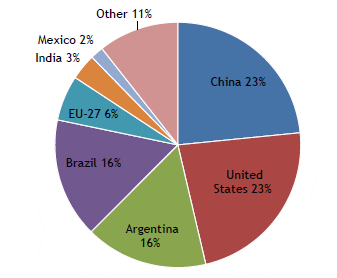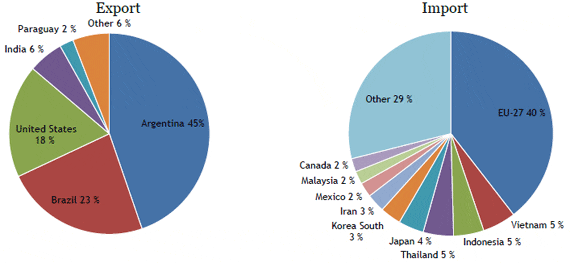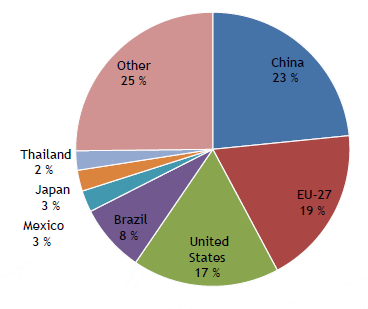Protein rich substitutes
Farmers and feedstuff producers value fishmeal mainly because of its high protein content and health enhancing nutrients. These characteristics are however not only found in fishmeal, but to different degree also in vegetable based products like rapeseed, soybean, corn and gluten. It is also possible to use terrestrial byproducts like meal from meat, blood, bone and feathers. Alternative marine-based substitutes from crustaceans, krill and algae are also useable as substitutes, and these sources may become more important in the future (Tacon 2008).
The common denominator of all of these organic substances is that they have a high content of protein and some contain omega-3 acids. Soybeans have a particularly high protein content and also contain favorable acids which have made it a very common substitute and complement to fishmeal. Since soybean meal is the most fitting and widespread vegetable alternative to fishmeal, I will in the statistical examinations in this paper focus on the relationship among fishmeal and soybean meal. A qualitative discussion of other vegetable substitutes will follow in chapter 6.
Production of soybeans
Soybean meal is the most used vegetable protein feed in the production of animal feeds. The production process is similar to that of fishmeal: The beans are crushed and then cooked to approximately 60°C. The beans are then squeezed to remove any liquids, then toasted and subsequently cooled. Depending on whether the hulls removed prior to cooking are added back to the mixture or not, the soybean meal will have a protein content of 44 to 47 per cent.
The US has historically been the largest producer of soybean meal in the world followed by China and South American countries. In the 2009/2010 harvest7 the total world production was 165 million tons of soybean meal, which is about 25 times the global fishmeal production. The US and China were each responsible for 23 per cent of total world production in the 09/10 season, and it is estimated by the USDA that China will surpass the US in the forthcoming years as the leading producer of soybean meal to meet its increasing demand for protein (USDA 2007). Brazil and Argentina each had 16 per cent of the 2009/2010 global harvest while the EU, India and Mexico produced 6, 3 and 2 per cent respectively. This means that the top four producers of soybean meal hold nearly 80 per cent of the global production.
World Production of Soybean Meal 2009/2010 (USDA 2011)

Trade and consumption of soybeans
While about 60 per cent of all fishmeal production is exported, only 30 per cent of all soybean meal production is globally traded. One important reason for this is that the biggest soymeal producers, China and the US, consume all or large parts of their crops each year. Many producers also prefer to import whole soybeans and produce the meal themselves, thus this will disappear in the official numbers. China has developed from being a major exporter of soybean meal to being the biggest importer in the second half of the 1990?s. As their production of soybean meal rose during the 2000?s their import quantity however declined, and they traded a non-significant amount of soybean meal in 2009/2010 (USDA 2011). Today, the most significant exporters of soybean meal are Argentina, Brazil and the US, while the most prominent importers are the EU-27 and East-Asian countries.
It is interesting to notice that the trade pattern of soybean meal and fishmeal show similar regional characteristics: net exporters are found in South America while important consumers are found in East Asia and the EU.
World Soybean Meal Export and Import 2009/2010 (USDA 2011)

Combining the USDA data from production, export and import a consumption overview can be established. This shows that China is the largest consumer of soybean meal, closely followed by EU-27 and the US.
World Soybean Meal Consumption 2009/2010 (USDA 2011)

January 2012

